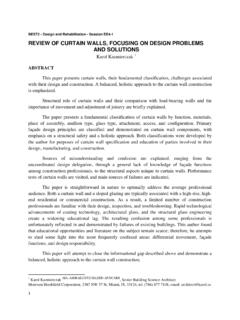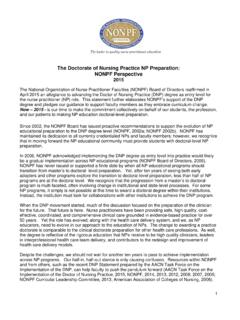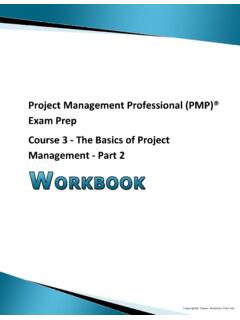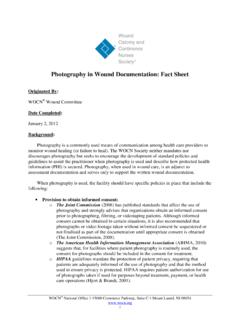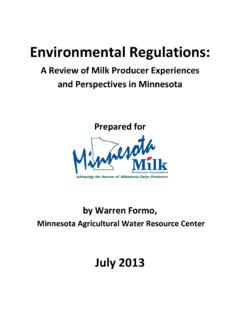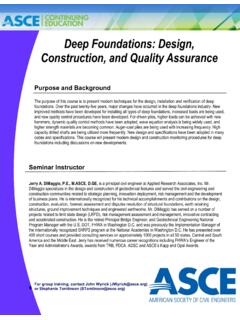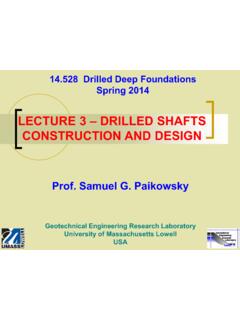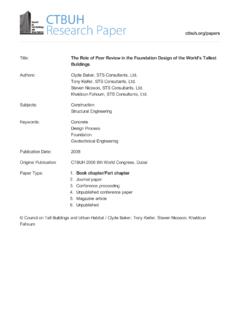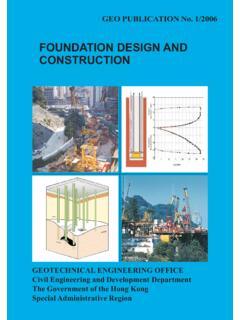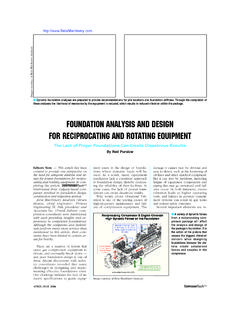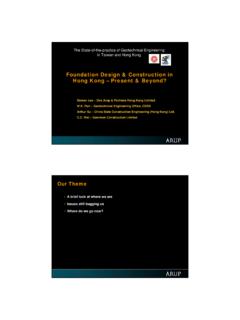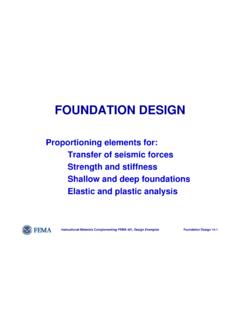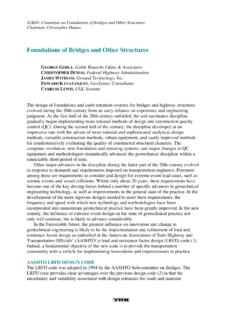Transcription of Foundation Analysis and Design - cdn.ymaws.com
1 5 Foundation Analysis and Design Michael Valley, Contents SHALLOW foundations FOR A SEVEN-STORY OFFICE BUILDING, LOS ANGELES, CALIFORNIA .. 3 Basic Information .. 3 Design for Gravity Loads .. 8 Design for Moment-Resisting Frame System .. 11 Design for Concentrically Braced Frame System .. 16 Cost Comparison .. 24 DEEP foundations FOR A 12-STORY BUILDING, SEISMIC Design CATEGORY D .. 25 Basic Information .. 25 Pile Analysis , Design and Detailing .. 33 Other Considerations .. 47 FEMA P-751, NEHRP Recommended Provisions: Design Examples 5-2 This chapter illustrates application of the 2009 Edition of the NEHRP Recommended Provisions to the Design of Foundation elements. Example completes the Analysis and Design of shallow foundations for two of the alternative framing arrangements considered for the building featured in Example Example illustrates the Analysis and Design of deep foundations for a building similar to the one highlighted in Chapter 7 of this volume of Design examples.
2 In both cases, only those portions of the designs necessary to illustrate specific points are included. The force-displacement response of soil to loading is highly nonlinear and strongly time dependent. Control of settlement is generally the most important aspect of soil response to gravity loads. However, the strength of the soil may control Foundation Design where large amplitude transient loads, such as those occurring during an earthquake, are anticipated. Foundation elements are most commonly constructed of reinforced concrete. As compared to Design of concrete elements that form the superstructure of a building, additional consideration must be given to concrete Foundation elements due to permanent exposure to potentially deleterious materials, less precise construction tolerances and even the possibility of unintentional mixing with soil.
3 Although the application of advanced Analysis techniques to Foundation Design is becoming increasingly common (and is illustrated in this chapter), Analysis should not be the primary focus of Foundation Design . Good Foundation Design for seismic resistance requires familiarity with basic soil behavior and common geotechnical parameters, the ability to proportion concrete elements correctly, an understanding of how such elements should be detailed to produce ductile response and careful attention to practical considerations of construction . In addition to the Standard and the Provisions and Commentary, the following documents are either referenced directly or provide useful information for the Analysis and Design of foundations for seismic resistance: ACI 318 American Concrete Institute.
4 2008. Building Code Requirements and Commentary for Structural Concrete. Bowles Bowles, J. E. 1988. Foundation Analysis and Design . McGraw-Hill. CRSI Concrete Reinforcing Steel Institute. 2008. CRSI Design Handbook. Concrete Reinforcing Steel Institute. ASCE 41 ASCE. 2006. Seismic Rehabilitation of Existing Buildings. Kramer Kramer, S. L. 1996. Geotechnical Earthquake Engineering. Prentice Hall. LPILE Reese, L. C. and S. T. Wang. 2009. Technical Manual for LPILE Plus for Windows. Ensoft. Rollins et al. (a) Rollins, K. M., Olsen, R. J., Egbert, J. J., Jensen, D. H., Olsen, K. Garrett, B. H. (2006). Pile Spacing Effects on Lateral Pile Group Behavior: Load Tests. Journal of Geotechnical and Geoenvironmental Engineering, ASCE, Vol. 132, No.
5 10, p. 1262-1271. Rollins et al. (b) Rollins, K. M., Olsen, K. G., Jensen, D. H, Garrett, B. H., Olsen, R. Egbert, J. J. (2006). Pile Spacing Effects on Lateral Pile Group Behavior: Analysis . Chapter 5: Foundation Analysis and Design 5-3 Journal of Geotechnical and Geoenvironmental Engineering, ASCE, Vol. 132, No. 10, p. 1272-1283. Wang & Salmon Wang, and C. G. Salmon. 1992. Reinforced Concrete Design . HarperCollins. Several commercially available programs were used to perform the calculations described in this chapter. SAP2000 is used to determine the shears and moments in a concrete mat Foundation ; LPILE, in the Analysis of laterally loaded single piles; and spColumn, to determine concrete pile section capacities. SHALLOW foundations FOR A SEVEN- STORY OFFICE BUILDING, LOS ANGELES, CALIFORNIA This example features the Analysis and Design of shallow foundations for two of the three framing arrangements for the seven-story steel office building described in Section of this volume of Design examples.
6 Refer to that example for more detailed building information and for the Design of the superstructure. Basic Information Description. The framing plan in Figure shows the gravity load-resisting system for a representative level of the building. The site soils, consisting of medium dense sands, are suitable for shallow foundations . Table shows the Design parameters provided by a geotechnical consultant. Note the distinction made between bearing pressure and bearing capacity. If the long-term, service-level loads applied to foundations do not exceed the noted bearing pressure, differential and total settlements are expected to be within acceptable limits. Settlements are more pronounced where large areas are loaded, so the bearing pressure limits are a function of the size of the loaded area.
7 The values identified as bearing capacity are related to gross failure of the soil mass in the vicinity of loading. Where loads are applied over smaller areas, punching into the soil is more likely. FEMA P-751, NEHRP Recommended Provisions: Design Examples 5-4 Figure Typical framing plan Because bearing capacities are generally expressed as a function of the minimum dimension of the loaded area and are applied as limits on the maximum pressure, foundations with significantly non-square loaded areas (tending toward strip footings) and those with significant differences between average pressure and maximum pressure (as for eccentrically loaded footings) have higher calculated bearing capacities. The recommended values are consistent with these expectations.
8 Table Geotechnical Parameters Parameter Value Basic soil properties Medium dense sand (SPT) N = 20 = 125 pcf Angle of internal friction = 33 degrees 127'-4"25'-0"25'-0"25'-0"25'-0"25'-0"1'- 2"1'-2"1'-2"25'-0"25'-0"25'-0"25'-0"25'- 0"25'-0"25'-0"1'-2"177'-4"NChapter 5: Foundation Analysis and Design 5-5 Table Geotechnical Parameters Parameter Value Net bearing pressure (to control settlement due to sustained loads) 4,000 psf for B 20 feet 2,000 psf for B 40 feet (may interpolate for intermediate dimensions) Bearing capacity (for plastic equilibrium strength checks with factored loads) 2,000B psf for concentrically loaded square footings 3,000B' psf for eccentrically loaded footings where B and B' are in feet, B is the footing width and B' is an average width for the compressed area.
9 Resistance factor, = [This factor for cohesionless soil is specified in Provisions Part 3 Resource Paper 4; the value is set at for vertical, lateral and rocking resistance.] Lateral properties Earth pressure coefficients: Active, KA = At-rest, K0 = Passive, KP = Ultimate friction coefficient at base of footing = Resistance factor, = The structural material properties assumed for this example are as follows: f'c = 4,000 psi fy = 60,000 psi Seismic Parameters. The complete set of parameters used in applying the Provisions to Design of the superstructure is described in Section of this volume of Design examples. The following parameters, which are used during Foundation Design , are duplicated here. Site Class = D SDS = Seismic Design Category = D FEMA P-751, NEHRP Recommended Provisions: Design Examples 5-6 Design Approach.
10 Selecting Footing Size and Reinforcement. Most Foundation failures are related to excessive movement rather than loss of load-carrying capacity. In recognition of this fact, settlement control should be the first issue addressed. Once service loads have been calculated, Foundation plan dimensions should be selected to limit bearing pressures to those that are expected to provide adequate settlement performance. Maintaining a reasonably consistent level of service load-bearing pressures for all of the individual footings is encouraged since it will tend to reduce differential settlements, which are usually of more concern than are total settlements. Once a preliminary footing size that satisfies serviceability criteria has been selected, bearing capacity can be checked.
